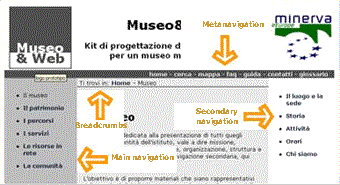
Museo&Web
Planning Kit for a Quality Site for Small and Medium Sized Museums
Navigation Tools
Navigation tools are at least as important as the contents of a site.
Their aim is to:
- Give users an idea of the contents of the site
- Give an idea of how the site is structured in order to assist orientation.
The key tools for navigation are:
 key tools within a web page |
Meta-navigation
This is a section of the page that contains ready-to-use tools, with elements for communication and general functions.
All the elements of meta-navigation should be grouped visibly together in the same area of every page in order to give the impression of a single block.
Main navigation
Main navigation is often placed in a column to the left of the page.
This option has the advantage of being always in the foreground and
is easily adapted to the size of the window. It is also clearly distinguished
from other navigation systems present. Indeed, it is the most commonly
used format in Web sites. The navigation bar is one of the most important
elements of the page because it gives users a clear idea of the contents
and allows for browsing the site structure without disorientation.
For this reason the following points are important:
- users must be able to remember contents easily and thus:
- the navigation bar should not contain more than 6 or 7 elements; This is commonly accepted as the limit for short term memory,
- each element should have a Meaningful name that immediately gives an idea of the contents of the page. The elements are generally linked to secondary Home pages that describe the contents of the area. (Page elements). For further clarity, supplementary information on each element can be added. A small window that appears on passing the mouse over the link title can be used for this purpose. Within this window there should be a short description of the destined link, or, in this case, the sections of the site,
- the elements should be presented in the form of a real list, i.e. in text form and not as images,
- the main navigation bar should be in the same position on all pages.
Secondary Navigation
This is a system of secondary navigation (index), separate from the main navigation and which includes only the list of sub-sections of the single area in question. In the prototype it was positioned in a column to the right of the page.
Contextual Navigation
This is a navigation system that links a document contextually with a wider group of documents in order to form a thematic dossier. Contextual navigation is positioned to the right of the body of the page structure and contains links to all the documents that form the dossier. The documents may be:
- text documents,
- multimedia documents,
- links to external sites.
There should be a common contextual navigation menu for all documents in the dossier (where they belong to the site) and it should visibly and graphically refer to the central text of the current document.
Breadcrumbs
Breadcrumbs show users their exact position within the site structure during navigation through the various levels into which the site is organised. It is a navigation system that allows users to jump to previous points of their path without having to repeatedly use the “Back” button. Through this system, users immediately perceive the structure of information and build a map by associating of the type of a document with the path to retrace it. Breadcrumbs show the path from the Home page to the current page. In every page except the Home page, they are organised as follows:
Home>Section>Sub-section>Current page
where Home refers to the Home Page and Section, Sub-section and Current page are, respectively, the names of the section, the sub-section and the current page. The path shows the position of the current page within the site structure. The elements of the path or route, are active links. This means that by clicking on the links, users can immediately return to previous points of their path. The current page, however, should not be an active link. It is generally considered a serious error to have live links to the current page unless these lead to different points of the said page. The various points on the path can be indicated using the character > (the symbol for “greater than”). Other characters such as / (slash) or => (is greater than), also give a sense of progression.
Meaningful names should be used to label the path (with the exception of the term “Home page” which has now entered common usage). Areas and sections usually use the names that appear in main navigation (section) and secondary navigation (sub-section). The current page should be indicated using the page title. The path or route can appear at the top of the page (on the first line, aligned to the left) of the area contained in the page structure. This makes it immediately visible and does not compromise the space dedicated to the contents of the page. The paths should be realised using text, not pictures or images such as arrows or various graphic elements such as Windows file symbols. Symbols and pictures would compromise legibility and accessibility.